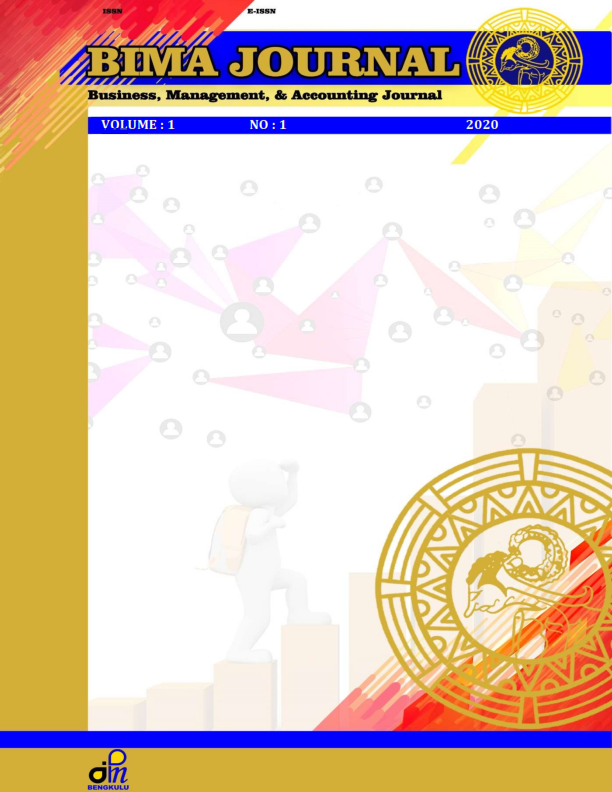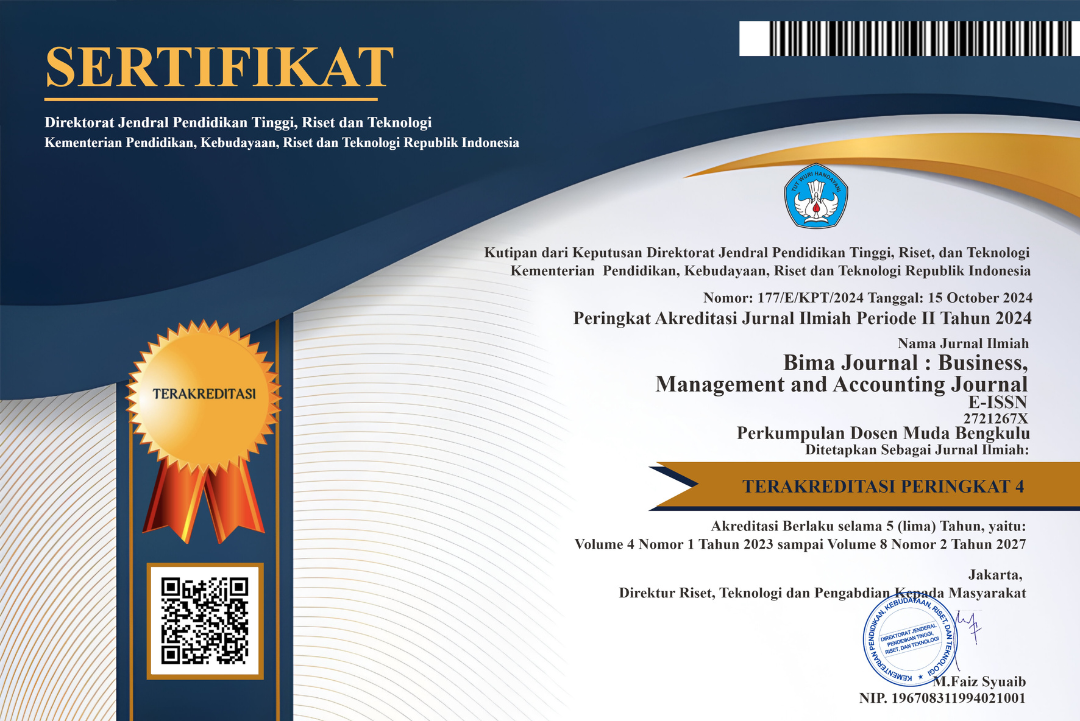Effect of Smartphone Choice, Customer Satisfaction and Reason to Change Smartphone on Smartphone Repurchase
DOI:
https://doi.org/10.37638/bima.3.2.75-82Keywords:
Smartphone choice, Customer Satisfaction, Reason to Change, Smartphone RepurchaseAbstract
Advances in Smartphone technology make the growth of Smartphone users among the people more rapidly. The high growth of Smartphone users makes Smartphone manufacturers compete with each other in understanding market needs. Every competing company actually has the same goal, namely how to make the products that are made can be well received by consumers. In accordance with sales data of smart cellphones (Smartphones) that have been released by International Data Corporation (IDC) from the first quarter of 2017 to the third quarter (Q3) - 2018 experienced sales fluctuations. Smartphone sales in 2018 fell by 5.9%. Similarly, the number of smartphone shipments in Indonesia in the third quarter (Q3) -2018 reached 8.6 million units, up 18% annually. But from quarter to quarter it decreased by 9%. Within 1-2 years Indonesian people like to switch smartphones, more than 56% of respondents replace their smartphones with new ones. This is consistent with data from the MARS research institute conducting a survey of 290 respondents in the Jakarta, Bogor, Depok, Tangerang and Bekasi areas. Within a period of more than 2 years, there were 20.6% of Smartphone users making smartphone replacements. The fastest duration that users do is within 3 months, done as much as 2, 4%. Every new smartphone launched, the interest of the people of Indonesia will certainly remain high. Consumer behavior when buying any product including smartphones not only concerns his own behavior, but a combination of the behavior of others who help or support the purchasing process that can work as an initiator, influencer, and decision maker and the level of involvement of all these people may differ in each purchase. There are many variables that influence consumer behavior including, age, sex, personal motivation, needs, attitudes and values, personality characteristics, socio-economic and cultural background, professional status to social influences such as family, friends, colleagues and society as a whole. This research was conducted to determine the effect of Smartphone choice, Customer Satisfaction, Reason To Change Smartphone on Smartphone Repurchase. The methodology of this research is to collect data in the form of questionnaires distributed online to respondents who are consumers of Smartphone users, the method used in this study is a quantitative method by collecting a sample of approximately 400 respondents. Based on the results of data analysis found that variables consisting of Smartphone choice, Customer Satisfaction and Reason To Change Smartphone and a positive and significant effect on Repurchase.
References
Ahmad, Z., & Ahmad, J. (2014). Consumer Purchase Behavior in Cellular Service Sector of Pakistan. IOSR Journal of Business and Management (IOSR-JBM), 16(5), 2319–7668.
Al-Abdi, Y., & Kang, Y. (2010). A Three-Dimensional Customer Commitment Model: Its Impact on Relational Outcomes. University of Manchester.
Al Ardi, A. N., & Rachmawati, I. (2014). Pengaruh Kualitas Produk Smartphone Samsung Berbasis Android Terhadap Kepuasan Konsumen Dalam Menggunakan Produk Samsung Galaxy S4 (Studi Di Bandung Tahun 2014). EProceedings of Management, 1(3).
Anastuti, K. U., Arifin, Z., & Wilopo. (2014). Pengaruh Diferensiasi Produk terhadap Kepuasan Pelanggan. Jurnal Administrasi Bisnis (JAB), 7(1), 1–9.
Belopa, E. M. (2015). Hubungan Kepercayaan Merek dan Persepsi Kualitas dengan Minat Beli Ulang Produk Kecantikan Silver International Clinic Balikpapan. Psikoborneo: Jurnal Ilmiah Psikologi, 3(1), 659 – 671.
Beyari, H., & Abareshi, A. (2018). An Empirical Study of How Social Influence Impacts Customer Satisfaction with Social Commerce Sites. International Conference of Reliable Information and Communication Technology, 973–984. Springer.
Harwani, Y., & Safitri. (2017). Security and Ease of Use Effect on Customers’ Satisfaction Shopping in Tokopedia. Journal of Resources Development and Management, 33(2017), 1-10.
IDC. (2019). Smartphone Market Share. Diambil kembali dari IDC The Analyze Future. Retrieved from IDC website: https://www.idc.com/promo/smartphone-market-share/vendor
Jain, S., & Singh, B. (2019). Consumer Behavior Toward Mobile Phone Handsets. International Conference on Innovative Computing and Communications, 61–69. Springer.
Johnson, M. D., Gustafsson, A., Andreassen, T. W., Lervik, L., & Cha, J. (2001). The Evolution and Future of National Customer Satisfaction Index Models. Journal of Economic Psychology, 22(2), 217–245.
Karjaluoto, H., Karvonen, J., Kesti, M., Koivumäki, T., Manninen, M., Pakola, J., … Salo, J. (2005). Factors Affecting Consumer Choice of Mobile Phones: Two Studies from Finland. Journal of Euromarketing, 14(3), 59–82.
Kim, K. J., & Sundar, S. S. (2014). Does Screen Size Matter for Smartphone Utilitarion and Hedonic Effect of Screen Sizeon Smartpone Adoption. Cyberpsychology, Behavior, And Social Networking, 17(7), 466–473.
Kim, M. K., Won, S. F., Chang, Y., & Park, J.-H. (2016). Determinants of Customer Loyalty in the Korean Smartphone Market: Moderating Effects of Usage Characteristics. Telematics and Informatics, 33(2016), 936–949.
Luthfi, A. (2010). Di Indonesia, Smartphone Sudah Menjadi Kebutuhan Utama. Retrieved from Okezone Techno website: https://techno.okezone.com/ read/2014/05/13/57/984293/di-indonesia-smartphone-sudah-menjadi-kebutuhan-utama
Mack, Z., & Sharples, S. (2009). The Importance of Usability in Product Choice: A Mobile Phone Case study. Ergonomics, 52(12), 1514–1528.
Mbango, P. (2018). Examining the Effects of Customer Satisfaction on Commitment and Repurchase Intentions of Branded Products. Cogent Social Sciences, 4(1), 1521056.
Mokhli, S., & Yaakop, A. Y. (2012). Consumer Choice Criteria in Mobile Phone Selection: An Investigation of Malaysian University Students 203-212. International Review of Social Sciences and Humanities, 2(2), 203–212.
Panjaitan, D. (2018). Pengaruh Service Excellence terhadap Customer Satisfaction pada PT. Angkasa Pura II (Studi Kasus pada Bisnis Aeronautika Husein Sastranegara International Airport Tahun 2018) (Telkom University). Telkom University. Retrieved from https://openlibrary.telkomuniversity.ac.id
Rayhanawati. (2017). Analisis Preferensi Konsumen dalam Memilih Smartphone di Kalangan Generasi Y dan Z di Kota Bandung Tahun 2017 (Telkom University). Telkom University. Retrieved from https://openlibrary.telkomuniversity.ac.id
Saragih, H. P. (2018). Rupiah Tertekan, Jualan Handphone Turun di Kuartal III-2018. Retrieved from CNBC Indonesia website: https://www.cnbcindonesia.com/ fintech/20181213140456-37-46239/rupiah-tertekan-jualan-handphone-turun-di-kuartal-iii-2018
Sata, M. (2013). Factors Affecting Consumer Buying Behavior of Mobile Phone Devices. Mediterranean Journal of Social Sciences, 4(12), 103.
Uddin, M. R., Lopa, N. Z., & Oheduzzaman, M. (2014). Factors Affecting Customers’ Buying Decisions of Mobile Phone: A Study on Khulna City, Bangladesh. International Journal of Managing Value and Supply Chains (IJMVSC), 5(2), 21–28.
Utami, A. D., & Trianasari. (2019). Pengaruh Kualitas Produk, Merek dan Pengalaman Belanja terhadap Kepuasan Pelanggan pada Aplikasi Shopee. Telkom University.
Wästerlund, D. S., & Kronholm, T. (2017). Family Forest Owners’ Commitment to Service Providers and the Effect of Association Membership on Loyalty. Small-Scale Forestry, 16(2), 275–293.
Downloads
Additional Files
Published
Issue
Section
License
An author who publishes in the BIMA JOURNAL: Business, Management, and Accounting Journal agrees to the following terms:
Author retains the copyright and grants the journal the right of first publication of the work simultaneously licensed under the Creative Commons Attribution-ShareAlike 4.0 License that allows others to share the work with an acknowledgement of the work's authorship and initial publication in this journal
Submission of a manuscript implies that the submitted work has not been published before (except as part of a thesis or report, or abstract); that it is not under consideration for publication elsewhere; that its publication has been approved by all co-authors. If and when the manuscript is accepted for publication, the author(s) still hold the copyright and retain publishing rights without restrictions. For the new invention, authors are suggested to manage its patent before published. The license type is CC-BY-SA 4.0.
BIMA JOURNAL: Business, Management and Accounting is licensed under a Creative Commons Attribution-ShareAlike 4.0 International License.
You are free to:
Share — copy and redistribute the material in any medium or format
Adapt — remix, transform, and build upon the material
for any purpose, even commercially.
The licensor cannot revoke these freedoms as long as you follow the license terms.
Under the following terms:
Attribution — You must give appropriate credit, provide a link to the license, and indicate if changes were made. You may do so in any reasonable manner, but not in any way that suggests the licensor endorses you or your use.
ShareAlike — If you remix, transform, or build upon the material, you must distribute your contributions under the same license as the original.
- No additional restrictions — You may not apply legal terms or technological measures that legally restrict others from doing anything the license permits.
Notices:
- You do not have to comply with the license for elements of the material in the public domain or where your use is permitted by an applicable exception or limitation.
- No warranties are given. The license may not give you all of the permissions necessary for your intended use. For example, other rights such as publicity, privacy, or moral rights may limit how you use the material.





















